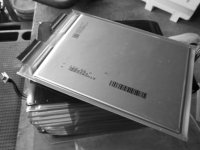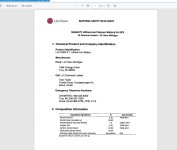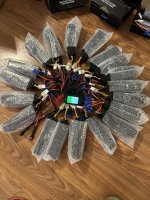I'm going to use identical LiPo batteries in parallel to have more Ah. 5S packs connected parallel both by power leads and balance leads. Let's say 6 batteries in parallel.
Also I want to connect those 5S6P packs to series so I have 20S 6P pack overall and use Li-ion Daly BMS to manage it.
It should play out ok, but there's always some itch in the back of my neck that I have been missing something completely.
So, what do you think about it?
I think your idea is no bueno.
If by LiPo, you mean Lithum Polymer, a Li-ion BMS won't work.
Besides being different chemistries and hence different Voltage values (top, storage, ready to take a dive at too low a Voltage), parallel balancing Lithum Polymer cells doesn't work out. Think about it, what does the balance charger see w/ a paralleled pair, The avg. right? One cell could be at 3.5V and the other at 4.0V and the balance charger or BMS will "see" 3.75. With Lithum Polmer's proclivity to have cells get out of wack, unless you are lucky that day, the 2 cells are likely to not be the same, say within .03V. If the 2 cells aren't close at the start and stay close thru the charge/balance cycle, a balance charger or a BMS for that matter, can't do anything helpful.
To balance paralelled Lithum Polymer packs, you need to "break" the packs into 1P. That's why the "Toy" balance chagers have many models that will charge multible packs at one time.
I start with the largest bricks I can use, like 6S/10,000 mA bricks, so two of them configured at 2S/1P gives me 48V or so and a theorictical 10,000 mA potential. But what I really like is 7S, so two of those are 14S
If one is careful about Depth of Discharge (DOD), don't overchage and don'y connect balance leads in parallel, pretty soon the cells will stay pretty much the same value, then it becomes a matter of just ck'ing the Voltages and for that I use Battery Medics. I got a bunch of them. If the cells are within .05V max at top charge, you are good to go. I always put my Lithum Polymer at storage value. if they are not going to be used for a couple of days or more, so at that point, they are get balanced.
I never go below 3.5V (there are alarms for this if the controller doesn't have a Voltage Cut-off , but they are hard to use. I use a LCD display Voltmeter, but I've been doing this for so long, I just know about where my batt.s are at by how long/how far I've been riding. Actually, I don't go below 3.7V because, With Lithum Polymer's sm size, I can carry more battery than I will ever use on one ride (No range anxiety here)
Your reasoning behind this plan is a little faulty too. Adding parallel batteries doesn't give the Ebike "more Amps., that is a function of the motor/controller/load synergy. What it does do, it doubles the rated max discharge rating of the pack, but that is not really a big concern with normal ebikes, at least not for me. Upping the system Voltage not only increases the speed, but adds a little capacity as well. Big Amps really help climbing hills, if the controller, wires, and connectors don't fry. Easier to up the Volts than Amps and that's why like 7S Lithum Polymer so much, the caps in most controller's are 54V rated and 14S (52V)won't blow them. Can't really get big bricks in 7S, so I make my own. Can't use a balance charger with 7S as well, so I use a Meanwell bulk charger and charge at 14S and use Battery Medics to passively balance. Slow, but one can walk away (no need to watch BM's work ).







